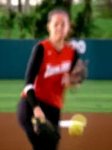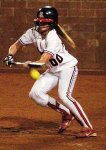swiveling the forearms gets the bat going rearward which resists turning with the hips so you can get separation.
this requires muscle action that externally rotates the back arm while keeping the elbow up and back as much as possible, then twisting/supinating the forearm (Mankin: "roll" the back forearm).
using the muscles to primarily lower/ADduct the back arm or losing back arm/elbow extension will interrupt stretch/load/separation.
back elbow should feel like it stays up and back, do not let it actively go down and forward.
see latest Mankin:
YouTube - MrBatSpeed's Channel
YouTube - MrBatSpeed's Channel
this requires muscle action that externally rotates the back arm while keeping the elbow up and back as much as possible, then twisting/supinating the forearm (Mankin: "roll" the back forearm).
using the muscles to primarily lower/ADduct the back arm or losing back arm/elbow extension will interrupt stretch/load/separation.
back elbow should feel like it stays up and back, do not let it actively go down and forward.
see latest Mankin:
YouTube - MrBatSpeed's Channel
YouTube - MrBatSpeed's Channel





